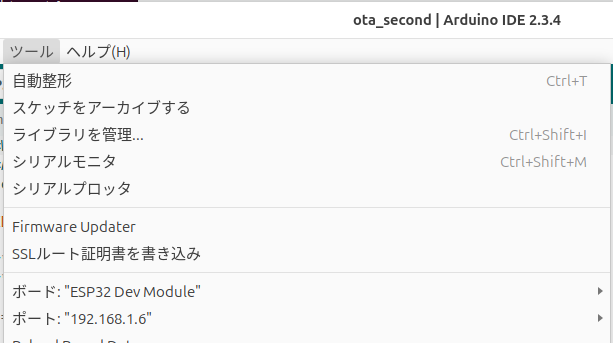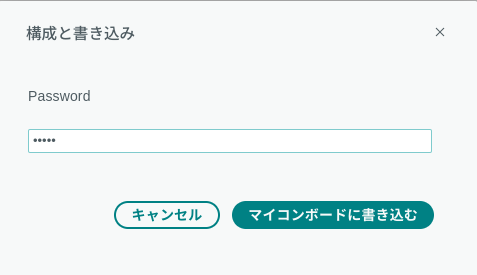OTA (OVER The Air) の使い方です。
Arduino IDE からのプログラムの更新を USB 経由でなく、WiFi 経由で行うものです。
最初のプログラムを USB で書き込み、次のプログラムは、WiFi 経由で行います。
注意すべきは、更新するプログラムに、必ず OTA の仕組みを組み込むことです。
共通の設定
config.h
#define SSID "****"
#define PASSWORD "*****"
connectWiFi.ino
// ---------------------------------------------------------------------
/*
connectWiFi.ino
Mar/08/2025
*/
// ---------------------------------------------------------------------
void connectWiFi()
{
WiFi.begin(ssid, password);
Serial.print("WiFi connecting...");
while(WiFi.status() != WL_CONNECTED) {
Serial.print(".");
delay(100);
}
Serial.print(" connected. ");
Serial.println(WiFi.localIP());
}
// ---------------------------------------------------------------------
最初に USB で書き込むプログラム
ota_base.ino
#include <WiFi.h>
#include <ArduinoOTA.h>
#include "config.h"
const char* ssid = SSID;
const char* password = PASSWORD;
void setup() {
Serial.begin(115200);
Serial.println("*** ota_base.ino aaa ***");
connectWiFi();
// OTAの初期化
ArduinoOTA.begin();
}
void loop() {
ArduinoOTA.handle(); // OTAのハンドリング
delay(100);
if ( WiFi.status() == WL_DISCONNECTED ) {
connectWiFi();
}
}
プログラムが起動したら、 USB をパソコンからはずして、電源供給に切り替えます。
OTA で書き込むプログラム
LED 14 を点滅させます。
ota_second.ino
#include <WiFi.h>
#include <ArduinoOTA.h>
#include <uTimerLib.h>
#include "config.h"
#define LED_TEST 14
const char* ssid = SSID;
const char* password = PASSWORD;
bool led_on = false;
int count = 0;
void setup() {
Serial.begin(115200);
Serial.println("*** OTA Update Example ***");
connectWiFi();
// OTAの初期化
ArduinoOTA.begin();
pinMode(LED_TEST, OUTPUT);
TimerLib.setInterval_us(blink_led, 2000000);
}
void blink_led() {
led_on = !led_on;
digitalWrite(LED_TEST, led_on);
}
void loop() {
ArduinoOTA.handle(); // OTAのハンドリング
// ここに他の処理を追加できます
delay(100);
if ( WiFi.status() == WL_DISCONNECTED ) {
connectWiFi();
}
count++;
}
パスワードを要求されますが、設定してないので、
aa でも bb でも何かを入力するだけでオーケーです。
次の更新プログラム
LED 12 を点滅させます。
ota_third.ino
#include <WiFi.h>
#include <ArduinoOTA.h>
#include <uTimerLib.h>
#include "config.h"
#define LED_TEST 12
const char* ssid = SSID;
const char* password = PASSWORD;
bool led_on = false;
int count = 0;
void setup() {
Serial.begin(115200);
Serial.println("*** OTA Update Example ***");
connectWiFi();
// OTAの初期化
ArduinoOTA.begin();
pinMode(LED_TEST, OUTPUT);
TimerLib.setInterval_us(blink_led, 2000000);
}
void blink_led() {
led_on = !led_on;
digitalWrite(LED_TEST, led_on);
}
void loop() {
ArduinoOTA.handle(); // OTAのハンドリング
// ここに他の処理を追加できます
delay(100);
if ( WiFi.status() == WL_DISCONNECTED ) {
connectWiFi();
}
count++;
}
次の更新プログラム
LED 27 を点滅させます。
ota_fourth.ino
#include <WiFi.h>
#include <ArduinoOTA.h>
#include <uTimerLib.h>
#include "config.h"
#define LED_TEST 27
const char* ssid = SSID;
const char* password = PASSWORD;
bool led_on = false;
int count = 0;
void setup() {
Serial.begin(115200);
Serial.println("*** OTA Update Example ***");
connectWiFi();
// OTAの初期化
ArduinoOTA.begin();
pinMode(LED_TEST, OUTPUT);
TimerLib.setInterval_us(blink_led, 2000000);
}
void blink_led() {
led_on = !led_on;
digitalWrite(LED_TEST, led_on);
}
void loop() {
ArduinoOTA.handle(); // OTAのハンドリング
// ここに他の処理を追加できます
delay(100);
if ( WiFi.status() == WL_DISCONNECTED ) {
connectWiFi();
}
count++;
}

